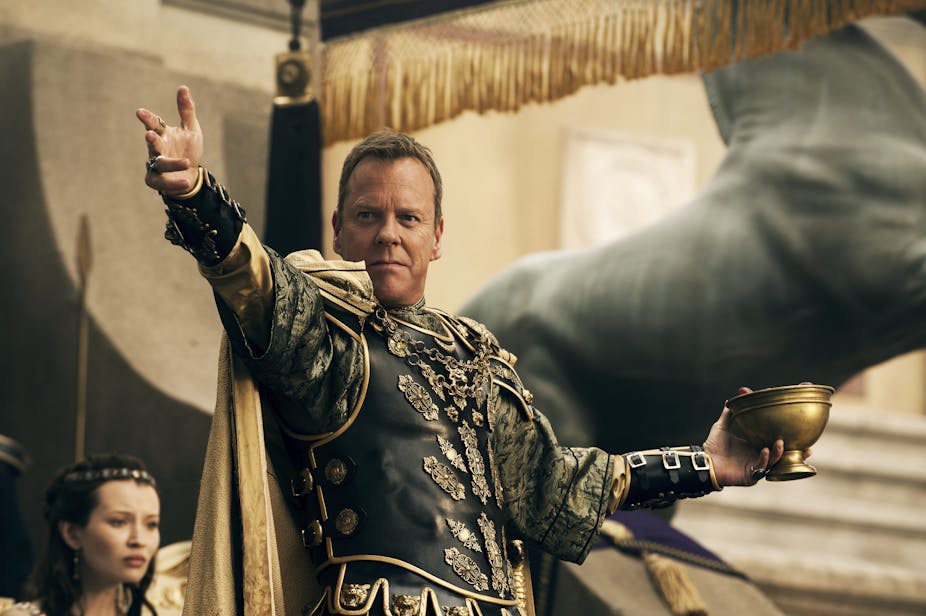Take one brooding hunk, enslaved as a gladiator after the brutal slaughter of his family, who seeks revenge against the evil Roman empire. Lay on plenty of set-piece spectacular arena battles through which your hero, and his African rival-turned-comrade, can win fame and the love of the people. Throw in a crazed Roman emperor-figure, with more than a touch of camp, some spectacular sets and costumes, a chariot race or two, a love interest, and ramp up the tension before an explosive finale.
These are the cinematic ingredients that Hollywood throws together, time and again, when it turns to ancient Rome. The recent Pompeii film follows a very similar recipe to Gladiator (2000) – albeit less skilfully executed – while also drawing heavily on more recent films like Centurion (2010) and The Eagle (2011) in its depiction of the northern frontiers of the Roman Empire.
So many viewers of Pompeii will have left the cinema with a strong sense of déjà vu, perhaps accounting for the swiftly falling box office numbers. Not only does it recycle the familiar gladiator narrative, it also recalls the B-movie disaster flicks of the 1970s, to which critics have compared it.
In many ways, the makers of Pompeii missed a trick. This ancient city left a unique and fascinating mark on the historical record and the cultural imagination, through the dramatic nature of its demise and the unparalleled circumstances of its preservation. The ruins intrigue and seduce us with an apparent glimpse of an alternative ancient world, a view of domesticity – and decadence – that is very different to the pomp and grandiosity of Rome.
But the film only alludes in passing to the features of Pompeii that mark it out in the modern mindset: the idea (inaccurate though it is) of the city as a debauched “holiday resort”, for example. Despite the Pompeians’ loud complaints that they are not Roman themselves, the film squarely is. All it really needs from the doomed city is the catastrophic eruption of Vesuvius.

Yet despite all this rich history an utterly formulaic vision of ancient Rome dominates the movies. Should we be worried about it? In commercial terms, the powerful effects of genre conventions are hard to escape. Not only do they provide filmmakers with tried-and-tested blueprints for successful films, they offer studios and audiences the security of knowing how to market their product, and what to expect when shelling out for a ticket. In a multimillion dollar industry, breaking the “rules” of a familiar genre is often just too much of a gamble.
What’s more, ancient world epics know how to play by the rules better than many other genres. Pompeii might have looked like a Gladiator reboot, but the Ridley Scott film was itself a striking imitation of the 1964 The Fall of the Roman Empire. Although Hollywood historical epics thrive on technological innovation – as the difficulty of finding a 2D screening of Pompeii proves – they are deeply conventional, and keen to honour a cinematic tradition which spans the entire history of filmmaking.
Cinematic Romes are littered with motifs that signal this sense of tradition to viewers in the know. In the above clip for example, when Milo hurls a spear towards the Senator’s box in Pompeii’s arena, the film nods at a similar scene in Gladiator, which in turn looked back to Stanley Kubrick’s use of the same device in Spartacus.
Audience expectations shape these films’ approach to genre, but also their attitude towards historical authenticity. Lip service might be paid to giving a scholarly and “accurate” account of antiquity, but it’s usually far more important for a film to stick to what the general public thinks is accurate.
Take the appearance of the ancient city, for example. We’ve long known that sculpture and architectural detail would have been painted in bright colours, but this so offends our cherished notions of gleaming white marble temples that it’s rarely depicted on screen. And even if viewers know deep down that Hollywood deals in cliché, the fact remains that these are often the best stories. Who wants to see a film about a benevolent and completely sane Roman emperor?
This reminds us, finally, that popular culture keeps treading the same old Roman roads because of the cultural grip that the ancient empire still has on us. Grand narratives of imperialism and decadence, of power and hubris remain meaningful, and Rome is a shortcut for addressing them. Yet this only gives us half, if that, of the story of this ancient civilisation. The Roman world offers so much more than gladiators and Caesars, even if Hollywood rarely turns its lens on it.

